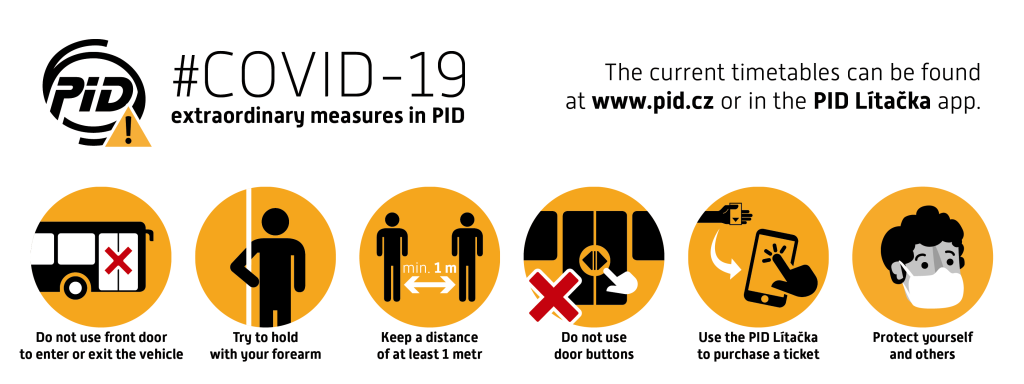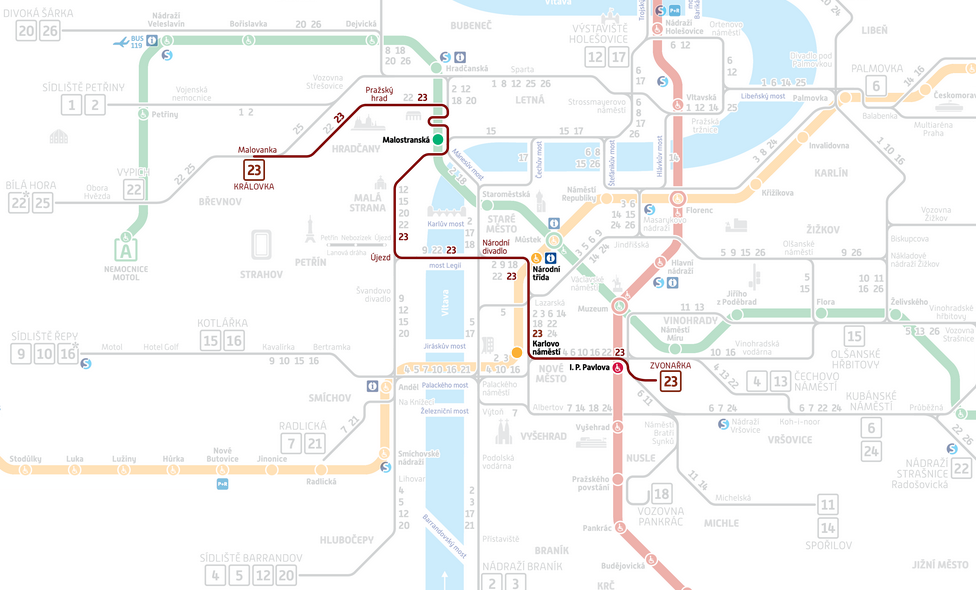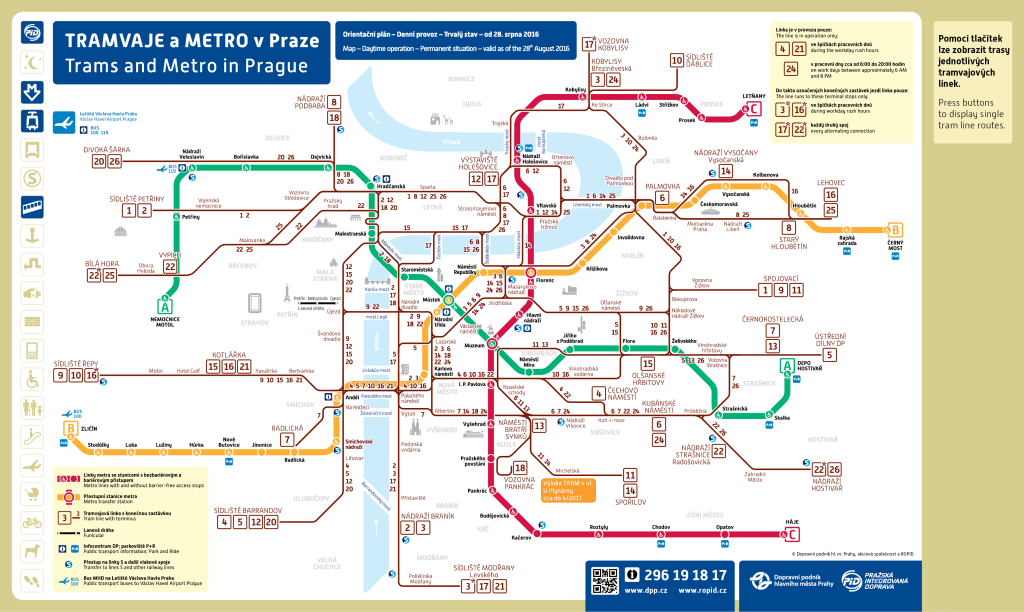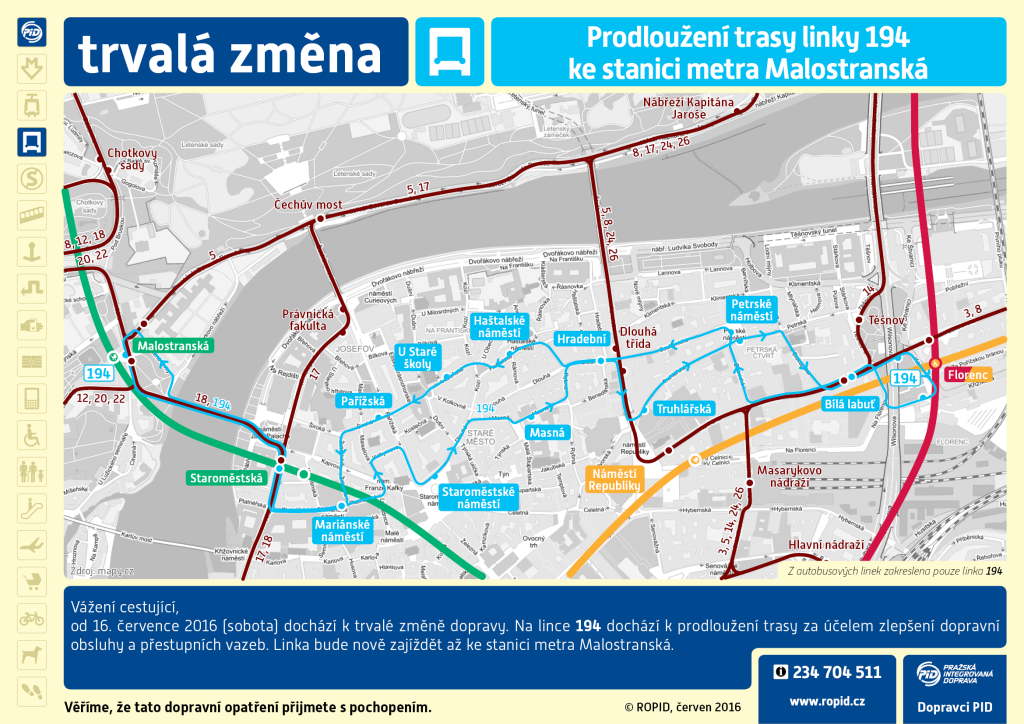Help improve orientation in Prague II
Help the new wayfinding in putting an end to lose oneself in the streets of Prague
Who hasn’t lost one’s way in our capital city? It happens even to native Praguers, let alone casual visitors. Today, there are multiple unrelated systems for navigating pedestrians, cyclists and travelers in Prague. It is a bleak situation, yet something can be done about it.
Čitelná Praha (Legible Prague) for a better life in the metropolis
The current information system has its roots in the 1970s and 1980s. It reflects the time of its creation and suffers from the layers of more or less conceptual updates. We are taking the best of it and building on this foundation to create a sophisticated navigation system that will improve everyday life in the city, whether you move around on your own, choose a mode of transport or a combination of the two.
Our project Čitelná Praha (Legible Prague) introduces a city wayfinding aimed at improving the quality of life for all those who navigate the metropolis. In such metropolitan jungles, you can easily find the entrance to the metro/underground/subway, get to the right platform or simply orient yourself on the streets or at traffic junctions. All you have to do is look around you a bit.
The author of Prague wayfinding design, which resulted from an international competition, is a Czech team consisting of the graphic design studio Side2, the atelier A69, and the architect and typography studio Superior Type.
Pedestrian trial operation at Holešovická tržnice
The gradual deployment of the new unified information system has already begun. It was tested at the Palmovka metro station in spring, where passengers have been orienting themselves according to the new features since last September.
These days we are running yet another trial this time for pedestrians at Holešovická tržnice near the freshly opened Štvanická lávka.
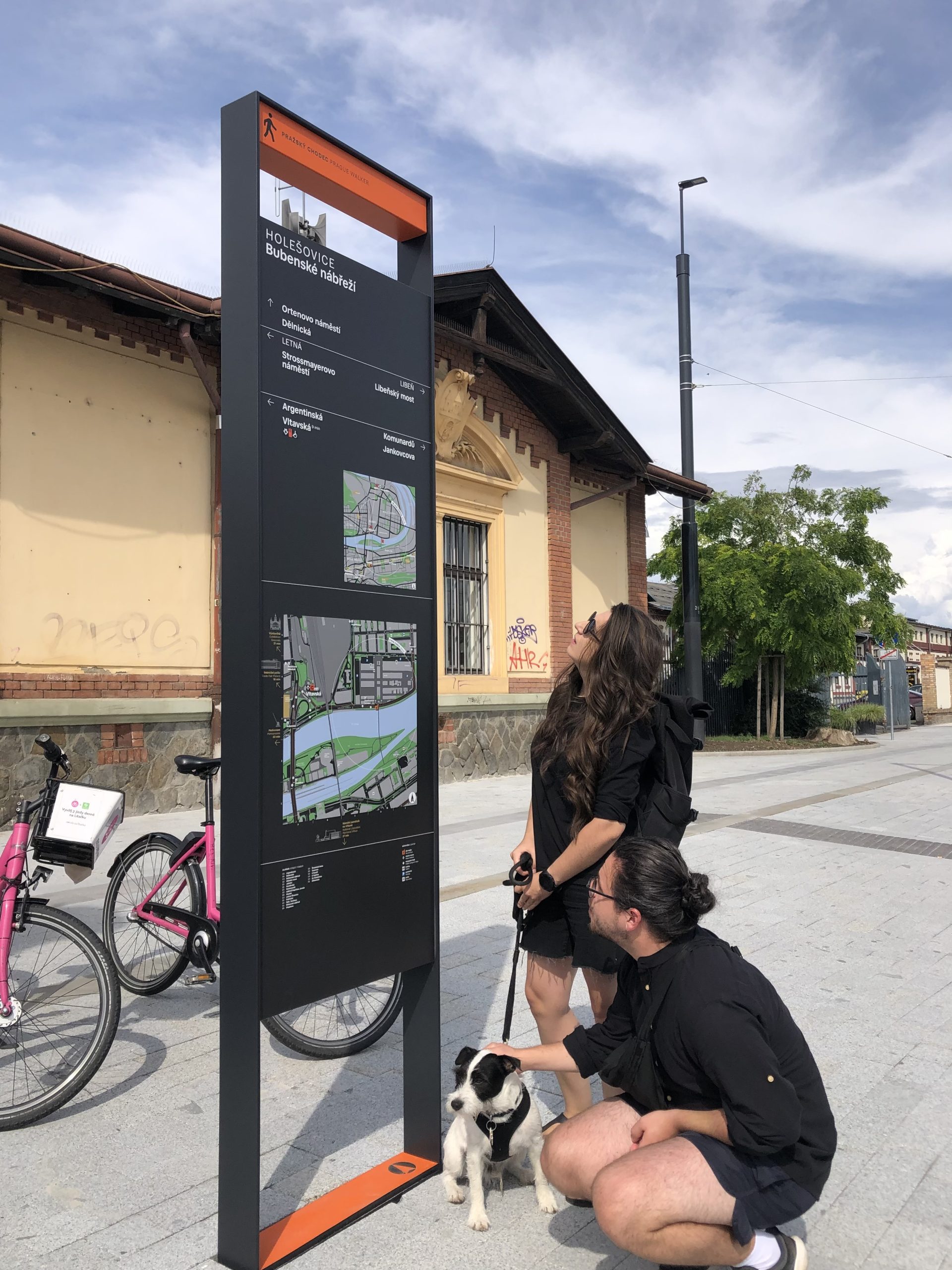
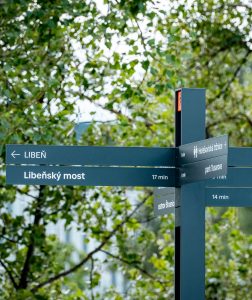
Thorough exploration and testing
A proper design approach simply cannot be done without thorough exploration and testing. And the experience from the field is extremely valuable and important. They help us to improve the system of Čitelná Praha (Legible Prague) and to prepare it for the city-wide rollout.
UX designer Dominika Potužáková from Bohemia design & research is exploring the user experience, inclusivity and accessibility of the features of Čitelná Praha (Legible Prague) in real life.

Test the new pedestrian navigation system with us
For the new pedestrian navigation system to serve everyone well, we need to test its functionality with different types of users – locals who know the city by heart, people who commute to Prague for work and are always in a hurry, tourists who don’t speak Czech but want to fully enjoy all its beauty, individuals with temporary or permanent mobility, vision, hearing, or other impairments, dog persons, parents with strollers, hikers with suitcases and backpacks, retirees, children, and everyone else.
We all have many common and a number of specific requirements that quality design and architecture help address, which is why we want to know yours! All you have to do is fill out a questionnaire.
Whether you are part of any group, whether you walk, use public transportation, a car, a bicycle, or combine all options, your feedback will help us incorporate your needs into the emerging wayfinding and make it the best for everyone.
How will the usability research take place?
During the usability research, we will stand nearby obelisk and signpost, give you a few tasks to perform with the wayfinding system in place and observe your reactions to the features of the new navigation system installed at Holešovická tržnice. After this, we will have a detailed discussion with you to understand the clarity, legibility and functionality of the new system.
For a 30-minute interview at the location respondents will be rewarded with a gift package and the opportunity to be among those who help make Prague more legible for everyone.
Would you like to be part of our research and help to ensure that no one gets lost in Prague again?
Please sign up via questionnaire here.
Help improve orientation in Prague
Čitelná Praha (Legible Prague) will conduct a users’ survey at Palmovka. Anyone can take part.
The end of getting lost in Prague and how you can contribute to it
Who hasn’t lost one’s way in our capital city? It happens even to native Praguers, let alone casual visitors. Today, there are multiple unrelated systems for navigating pedestrians, cyclists and travellers in Prague. It is a bleak situation, yet something can be done about it.
Čitelná Praha (Legible Prague) for a better life in the metropolis
The current information system has its roots in the 1970s and 1980s. It reflects the time of its creation and suffers from the layers of more or less conceptual updates. We are taking the best of it and building on this foundation to create a sophisticated navigation system that will improve everyday life in the city, whether you move around on your own, choose a mode of transport or a combination of the two.
Our project, Čitelná Praha (Legible Prague), builds on functional solutions of such systems found in other metropolises. In such metropolitan jungles, you can easily find the entrance to the metro/underground/subway, get to the right platform or simply orient yourself on the streets or at traffic junctions. All you have to do is look around you a bit.
Trial operation at Palmovka
The project, Čitelná Praha (Legible Prague), is a smart information system on the streets and public transport of a modern city. The author of its design, which appeared at an international competition, is a Czech team consisting of the graphic design studio Side2, the atelier A69, and the architect and typography studio Superior Type.
The gradual deployment of the new unified information system has already begun. It is being tested at the Palmovka metro station, where passengers have been orienting themselves according to the new features for several months.
For the new navigation system to serve everyone well, we need to test its functionality with different types of users, whether they are working people, children or students, people with reduced mobility, the elderly or foreigners. UX designer Dominika Potužáková, designers and researchers from Stride XL are exploring the user experience, inclusivity and accessibility of the features of Čitelná Praha (Legible Prague) in real life.
A proper design approach simply cannot be done without thorough exploration and testing. And the experience from the field is extremely valuable and important. They help us to improve the system of Čitelná Praha (Legible Prague) and to prepare it for the city-wide rollout.
Test the new navigation system
And you can help us with that too! All you have to do is fill out a questionnaire, through which we can reach out to you for a 90-minute interview* to get valuable feedback on how the new wayfinding system works. Selected participants will be rewarded with a voucher for 700 CZK* and the opportunity to be the ones to have helped make Prague more legible for all the people who move around in it, including you personally.
* Note: interview with children and parents takes 60 minutes and will be rewarded with a voucher for 500 CZK.
Join the survey here.
Walking tours combined with detailed interviews, whose participants will be selected from the completed questionnaires, are one of the ways we gather feedback. The second method of data collection we use in our project is observation of metro users’ behavior in real-life situations, combined with short interviews in the field. So don’t be surprised if you are approached by one of our researchers at Palmovka.
How will the interview take place?
During a group walk, we will walk with selected users all the way from the platform to the surface and back. We will simulate situations that you experience on a daily basis and observe your reactions to the features of the new navigation system installed at Palmovka. After this walk, we will have a detailed discussion with you to understand the clarity, legibility and functionality of the new system.
Fill out our questionnaire and be the one to help make Prague more legible for the people who move around in it, including you personally.
Legible Prague. Experts from around the world will sit on the Jury of an international competition for a new wayfinding system of the Czech capital.
At the end of this summer ROPID (Regional Organizer of Prague Integrated Transport) will announce an international design competition for a new wayfinding system of public transport and the area of the Czech capital, Prague. Together with Czechdesign, an experienced design competition organizer, they now present the Jury board which will decide on the winning design.
Aim of the competition
The aim of this competition is to select a team of experts, which shows capability to create a smart city navigation system fit for all citizens and visitors of the metropolis. The task will be to design a complex solution with emphasis on unity and legibility, which makes it easier for the public to move around the city.
„We realize that the competition results will imprint a new modern face on everything related to urban mobility for decades to come and that is why Prague pays a great deal of attention to this project. We believe that a new wayfinding system for Prague will become a design icon, thanks to which people from around the world will easily get to know our metropolis and we will help them not to get lost in it,” adds Petr Tomčík, the director of competition announcer, city organization ROPID.
Competition process
A limited two-stage design competition counts on the participation of both Czech and international teams, who will apply with their portfolios of relevant projects. An international Jury consisting of respected experts will then select competitors who will be invited into the first stage of the competition. Their task in this phase will be to process a complex assignment for the design of an overall information-navigation system concept with a practical typography and colour scale representation and especially functional principles all presented on various 3D models.
Presented solutions will be anonymously evaluated by the Jury board of which the most successful will be invited into the second stage of the competition. The exact number of participants in both stages will be specified within the competition announcement.
The Jury board and its importance
The Jury will consist of a dependent and independent part represented by 4 to 5 votes. The dependent part represents all the main stakeholders influencing urban mobility in Prague, independent jurors were approached from among leading Czech and global experts not only on graphic design or architecture, but above all on the complex discipline of information and wayfinding design.
„Our experience has proved many times that a well-established team of independent jurors is one of the most important factors in determining the quality and weightiness of the competition. It directly affects not only the process and results of the competition but also the motivation to sign up for potential contestants. We are thrilled that we have been able to connect Czech and foreign experts whose experiences are highly complementary. We believe that the selected jury team will make an important contribution to achieving a quality result of the new Prague wayfinding system,” said Jana Vinšová, Director of the Competition Administrator, Czechdesign.
Dependent Jury
The dependent Jury will consist of representatives of key stakeholders of this emerging unifying system, nominally Ing. et Ing. Petr Tomčík (director of ROPID), Ing. Adam Scheinherr, MSc., Ph.D. (councilor for transport – Prague City Hall), Rostislav Zapletal, Dis. (architecture competitions specialist – Prague Institute of Planning and Development), and MgA. Anna Švarc (architect of the Prague metro line – Prague Public Transit). Both parts of the Jury will have substitutes, who are present during the competition’s whole process and may, if needed, accept the function of juror.
Independent Jury
The independent Jury consists of Czech and international experts. Down below we are presenting their experiences and specialization.
doc. Ing. arch. Pavla Melková, Ph.D.
Pavla Melková is a leading Czech architect and urban designer, researcher and theoretician of architecture. The central theme of both her theoretical and practical work is the research of architecture’s influence on people and society. She has published many books on this subject and regularly lectures for experts and the public. Pavla promotes public space as a very important part of a city, which is a key element in making citizens feel pleasant. She has been a part of MCA architectonic studio since 1996, which she founded together with doc. ing. arch. Miroslav Cikán. Among her most notable projects is the National Memorial to the Heroes of the Heydrich Terror in Prague, revitalization of the Formalinka park in Nusle or the revitalization of Bastion u Božích muk in Prague, for which she has been awarded, together with her colleague Miroslav Cikán, the Grand Prix price by the Society of Czech Architects. Since 2011 she has been teaching at the Faculty of Architecture in Prague.
As a juror she evaluates the architectonic and urbanistic connection of the wayfinding system with the public space and its effect on a person.
Veronika Egger
Veronika Egger is an Austrian information designer focusing on inclusive design and mobility for more than 20 years. She believes in a collaborative and multidisciplinary approach to arrive at the best possible solution for everyone. In 1997 she founded her own company is-design which has been a partner in several mobility research projects with a number of papers published on mobility and inclusive information design. Veronika is a Board Member of the International Institute for Information Design (IIID), Life Fellow of the Communication Research Institute (CRI) and she cofounded design for all, an organisation promoting inclusive design in Austria. Among her many projects are environmental and route maps designed for Vienna Public Transport and information and orientation systems for public environments such as universities, hospitals, courts of justice, or historic spaces.
Veronika’s role as a juror will be to communicate her collaborative approach to a design process with strong focus on incorporating everyone’s abilities to make it easy and enjoyable for people to perceive, access and understand information that matters to them.
Mike Rawlinson
Mike Rawlinson is a design-planner and a founding director of City ID, a specialist design company based in New York and San Francisco, USA and Bristol, UK. He has extensive design management experience working on master planning, transportation, city identity, legibility and wayfinding projects.
He has led the development and delivery of innovative, ground-breaking design projects and strategies in the US, Europe and the UK seeking to improve people’s experience of places through the integration of urban design, wayfinding, identity and integrated transportation projects. He led masterplanning, transportation and wayfinding projects in Abu Dhabi, Moscow or New York City. In particular, Mike is credited with developing the Legible Cities movement, pioneered in Bristol and now extending worldwide, that seeks to improve people’s experience of places. In 2017, Mike was awarded the prestigious title of Royal Designer for Industry by the Royal Society of Arts for his work on Legible Cities and more widely for improving society’s understanding and experience of the built environment.
With his broad expertise his key role in the jury board will be the evaluation of a design process with emphasis on wayfinding solutions that integrate people, movement and places.
doc. MgA. Radek Sidun
Radek Sidun is a graphic designer and typographer. He is a sought-after consultant for font designers and foundries around the world. He founded the Briefcase Type Foundry together with Tomáš Brousil, which distributes Czech authors’ fonts. His position of renowned authority is also proven by a number of awards such as a Gold Medal at the European Design Awards 2013, Certificate of Typographic Excellence by Type Directors Club. He worked as a pedagogue at the Type Design and Typography studio of the Prague Academy of Arts, Architecture and Design (UMPRUM) for several years. Since 2019 Radek serves as a Vice-Rector for Communication and International Relations at UMPRUM.
As a juror he evaluates the typographic and graphic elaboration of submitted designs, their legibility, homogeneity of typography and other graphic elements such as pictograms and overall quality of the graphic designs.
Sam Gullam
Sam Gullam is a product designer working within the built environment with expertise in both the requirements of a system and the challenges of introducing physical components to a city that are both functional and appropriate to context. Together with his team from Lacock Gullam Studio, which he founded in 2001, he has been involved with multiple wayfinding projects such as Legible London Wayfinding, a pedestrian wayfinding system for the whole of London, and Bristol Legible City, both international benchmarks and an inspiration for numerous cities in creating their own unique pedestrian wayfinding schemes.
His key role will be to communicate and guard the overall connection between the individual components of the system, making it easily recognizable, with main focus on its ability to provide connected points of engagement that will in turn support the users’ formation of a mental map that can aid and encourage them to enjoy the city more comfortably and freely.
The Independent Jury Board Substitutes
prof. doc. Ivan Dlabač, M.A
Ivan Dlabač is a Czech designer focusing on industrial and product design. He applies his technical and technological knowledge, thanks to which he finds wide application in various branches of design. He is the founder and leader of the Divan Design studio, where he works as a technical and production consultant. Ivan Dlabač and his design studio in cooperation with the medical company LINET, are designing transport beds that have become a worldwide icon of the medical environment. There are countless products on which the studio has worked in its 23-year history. From the toothbrush through agricultural machinery to the houses themselves. At the same time, Ivan runs the only industrial design studio at the Prague Academy of Arts, Architecture and Design.
As a juror he evaluates the construction and technological specifics of the 3D design, their manufacturability and sustainability, their use and their fit in urban space.
Filip Blažek
Filip Blažek focuses on graphic design with a specialization for typography. He regularly contributes to professional periodicals and he is also the author of the Typobook and co-author of the book Practical Typography. He is also a co-founder and member of the editorial board of the Typo magazine, which deals with typography, graphic design and visual communication. He operates Typo.cz, a web portal dedicated to Czech and world graphic design. Since 1999 he has been lecturing for the professional public on the topic of typography and corporate identity. One of his successful projects is, for example, the 365 typo project. He currently teaches at the Academy of Arts, Architecture and Design in Prague and at ARCHIP.
As a juror he will be focusing on typographic elaboration of submitted designs, their functionality, legibility and successful implementation on every output in every size or material.
Important dates
The competition will be announced at the end of August 2021 through the Public Procurement Bulletin and the Tenders Electronic Daily of the Official Journal of the European Union. The competition notice will also be published on the profile of the Announcer, Czechdesign magazine as well as leading Czech and foreign architectural and design portals. The submission of competitive bids will be required via the online portal tenderarena.cz. The competition will run until the end of this year, results will be approved by the Prague city council and their announcement is planned for January 2022.
Competition organizer
The competition is administered by Czechdesign, a professional organization working in the design field for 20 years connecting both the public and the private sector with designers. It is a leading and most experienced design competitions organizer in the Czech Republic, actively asserting the fair conditions of tenders in the field. Czechdesign is running the most-read Czech web portal on design www.czechdesign.cz as well.
A new visual style for public transport in Prague and Central Bohemia
The Integrated Transport System, which covers all public transport in Prague and the Central Bohemian region, servicing 3 million people on more than 600 lines with 5 000 vehicles operated by 35 carriers, is getting a new unified look. The logo is changing together with additional graphical elements, including a new uniform design for all vehicles. The approved design came from a 2019 competition in which a jury composed of independent experts and representatives of the city of Prague and the Central Bohemian region selected the proposal submitted by the superlative.works studio. All newly ordered vehicles will be purchased in a combination of red and light grey in vertical stripes.
The aim of the new unified design for the PID was to present the public transport service as a modern, but more importantly easily readable and consistent 21st century system, as well as to make orientation easier and ensure that passengers can always find all the information they need intuitively in the same or similar places regardless of the mode of transport or carrier. Because the PID system is currently being extended throughout the entire Central Bohemian region, it needs a new modern look that would correspond with its full coverage of public transport in the city of Prague and the region, to ensure that users can tell at a glance that their PID ticket will be valid in the given vehicle. Until now, there were two different graphical manuals for bus lines in Prague and in the Central Bohemian region. Trains, trams and metro cars had no unified design at all.
The new design was also developed with wheelchair users and parents with prams in mind. Navigation will be much more user-friendly and easier to read. Today people have to pay attention to small stickers by the side of the door that are no longer visible once the door opens. Instead, the new style uses clear and distinctive guidance that is impossible to miss.
From 2022, the new graphical manual will be a binding annex to the PID quality standards which apply to all PID carriers in Prague and the Central Bohemian region, including bus carriers selected in the upcoming 2024 tender. Ultimately, the PID system will include about 700 metro cars, 900 trams, 350 trains and 3 000 buses; it should also include Prague trolleybuses for which a major comeback is being planned.
Details on the new PID logo and vehicle designs
The new look utilises the colour red as the connecting link between Prague and the Central Bohemian region because it is the traditional colour of the iconic T3 tram (the new design is actually using the same shade of red as the T3). Red and white are also the colours of the Prague logo; red is prominently featured also in the logo of the Central Bohemian region. Red is combined with light grey to unify the current patchwork system in which every vehicle looks slightly different. The current system uses at least 12 different shades of colour (not counting trains where there are even more than that); the new solution expects to use only 3 colours everywhere (including trains).
The most striking feature of the new visual style are red vertical stripes. These will improve safety, visibility at a distance and orientation when boarding, as they usually mark where the doors are located. These colours will also make public transport in Prague and the Central Bohemian region unmistakeable from other neighbouring systems. The selected shade of grey will also improve the perceived cleanliness of the vehicles, because the currently used white becomes dirty very quickly in normal traffic. A more prominent use of the PID logo will increase awareness of the unified system for all modes of transport.
IMPORTANT: Public transport during COVID-19 outbreak
With regard to the Government declaration of a state of emergency and a nationwide quarantine and related measures (e.g. restriction of free movement of people outside of their homes and workplaces, prohibition of all public events and closing of all primary and secondary schools and universities) the following temporary measures are introduced in public transport:
It is obligatory that all passengers must cover their mouth and nose (it is possible to use a home-made mask or scarf) in all vehicles and on all stops and stations of public transport.
Metro: operation maintained (with slightly longer intervals)
Trams: operation maintained (with slightly longer intervals), nostalgic line 23 not in operation
Urban buses: operation maintained (with slightly longer intervals, school lines (250 – 275) and the Airport Express line (AE) not in operation, some lines end operation already at 22:30)
Suburban and regional buses: operation maintained (with slightly longer intervals on some lines), school lines not in operation, some lines end operation already at 22:30
Trains: operation maintained, line S49 not in operation, some long distance and seasonal or nostalgic trains not in operation, weekend night trains from Prague at 2:30 not in operation (more information at www.cd.cz or www.arriva.cz)
Ferries: operation without restrictions
Funicular: out of operation
Furthermore, we kindly ask you to respect the following rules:
- Enter public transport only with covered nose and mouth
- Keep a safe distance from the others (on stops and in vehicles)
- Do not use the front doors to enter buses
- Touch the poles and handles as little as possible, if necessary, do it over your sleeve or use your forearm
- Do not use the door buttons, the drivers are obliged to open the doors
- If you sneeze, cover your mouth with your sleeve, not with your hand
- Use disposable tissues
- Use hand disinfection or wash your hands thoroughly with soap
- Reduce contact with other people (e.g. shaking hands)
- Travel only when necessary
Up-to-date information about timetables:
Information about ticket purchasing possibilities:
Thank you for your understanding
New nostalgic-tourist tram line 23 in Prague since 25th March 2017
Approximately at 12:00 AM on 25th March 2017 a new tram line number 23 will start operation in Prague. The whole line will be served only by the oldest type of T3 trams, which should also leave all other tram lines on the same date. The line will be operated during the whole year. Its main purpose is firstly to preserve this legendary and very popular type of tram T3 and secondly to lighten the busiest Prague tram line 22 mostly in the section between the city center and the Prague Castle.
New line 23 will be operated on the following route: Zvonařka – I. P. Pavlova – Karlovo náměstí – Národní třída – Národní divadlo – Újezd – Malostranská – Pražský hrad – Pohořelec – Malovanka – Královka.
The range of operation is approximately from 8:30 AM to 7:00 PM with the 30 minute interval. During the main tourist season on the weekends the interval will be shortened to 15 minutes. All regular PID tickets are valid on this line. Timetables can be found at stops or online.
Permanent changes to busline routes in October 2016 bring new lines and less transfers
From 15th of October, permanent changes to the bus network will be applied. The main motivation for the changes are comments from passengers and affected municipalities and transportation surveys performed in the traffic. In the bus network, from 115 lines, 23 will change route, 8 lines will start operation and 4 lines will be canceled and replaced by other lines.
- Bus schemes
- Timetables
- Line timetables in the PDF format
- Connection planner
New bus lines
117 Poliklinika Budějovická – Rosečská – Nádraží Krč – Nemocnice Krč – Čechtická – Nové dvory – Sídliště Lhotka – Tyršova čtvrť – Obchodní náměstí – Poliklinika Modřany – Čechova čtvrť
134 Podolská vodárna – Pražského povstání – Kavčí hory – Pankrác – Budějovická – Zelený pruh
145 Kobylisy – Vozovna Kobylisy – Sídliště Čimice
154 Strašnická – Jesenická – Nádraží Hostivař – Janovská – Newtonova – Háje – Brechtova – Brodského – Chodov – Koleje Jižní Město
182 Poliklinika Prosek – Prosek – Vysočanská – Spojovací – Nádraží Hostivař – Nad Košíkem – Opatov (only at workday peak times)
203 Poliklinika Budějovická – Rosečská – Nádraží Krč – Nad Havlem – Nemocnice Krč – IKEM – Kunratice – Volha – Roztyly – Chodovská tvrz – Brechtova – Poliklinika Háje – Milíčov – Háje
222 Černý Most – Svépravice – Xaverov – Výzkumné ústavy Běchovice (only at workday peak times)
396 Hloubětínská – Nádraží Satalice – Přezletice, Kocanda (renumbered and extended line 386)
Lines with route change
101 From the stop Záběhlická škola re-routed to Centrum Zahradní Město and Skalka, selected connections will continue to Sídliště Skalka (in the section Záběhlická škola – Nádraží Hostivař replaced by the line 154).
102 From the stop Kobylisy, selected connections are extended via Poliklinika Čumpelíkova to the final stop Šimůnkova.
121 Shortened to route Poliklinika Budějovická – Nádraží Braník (in the section Podolská vodárna – Poliklinika Budějovická replaced by the line 134).
136 From the stop Prosek the line is re-routed via Letňany and Tupolevova to Sídliště Čakovice (in the section Prosek – Vozovna Kobylisy replaced by the line 183).
138 From the stop Sídliště Spořilov extended via Starý Spořilov and Kačerov to the stop Nemocnice Krč and at workday peak times it is extended from Skalka to Zentiva.
140 Selected connections extended to Miškovice.
152 Extended to the route Českomoravská – Prosek – Kobylisy – Sídliště Čimice and newly operating also in evenings and on weekends.
157 From the stop Poliklinika Modřany re-routed to Násirovo náměstí.
158 Shortened to the route Letňany – Čakovice (replaced by the lines 140 and 195), selected connections extended to Třeboradice.
173 Shortened to the route Obchodní náměstí – Točná (replaced by the lines 117 and 157).
183 From the stop Třebenická re-routed via Sídliště Ďáblice to Vozovna Kobylisy (in the section Třebenická – Sídliště Čimice replaced by lines 145 a 152).
193 Cancelled in the section Šeberák – Chodov (replaced by the lines 177 and 203).
195 From the stop Letňany it is re-routed via Staré Letňany to the stop Avia Letňany / Krausova (in the section Letňany – Sídliště Čakovice replaced by the line 136).
196 Shortened to the route Smíchovské nádraží – Kačerov – Kloboučnická (in the section Michelská – Strašnická replaced by the lines 154 and 188; section Kačerov – Kloboučnická is operated only at workdays from approx 6 am to 8 pm).
201 Extended to the route Nádraží Holešovice – Bulovka – Letňany – Bakovská – Satalická obora – Černý Most.
202 From the stop OC Čakovice re-routed via Čakovice and Miškovice to Nádraží Kbely (in the section OC Čakovice – Černý Most replaced by the lines 158 and 201).
386 Renumbered to 396 and extended to the route Hloubětínská – Nádraží Satalice – Přezletice, Kocanda.
Cancelled lines
159 Nádraží Kbely – Náměstí Jiřího Berana (replaced by the line 202).
186 Hloubětínská – Satalická obora (replaced by the line 396).
205 Poliklinika Budějovická – Zelený pruh (replaced by the line 134).
293 Poliklinika Budějovická – Milíčov (replaced by the lines 138, 203).
Renumbered lines
273 Newly line 141 (Hloubětínská – Ve Žlíbku).
291 Newly line 148 (I.P. Pavlova – Karlovo náměstí – I.P.Pavlova).
295 Newly line 166 (Třeboradice – Domov seniorů Ďáblice).
296 Newly line 224 (Nádraží Horní Počernice – Sídliště Petrovice).
297 Newly line 155 (Nemocnice Vinohrady – Poliklinika Malešice).
386 Newly line 396 (Hloubětínská – Přezletice, Kocanda).
Thank you for your understanding.
ROPID
Permanent changes to TRAM network since 28th August 2016
From 28th of August 2016, after public discussions and comments, permanent changes to the tram network will be applied in order to strenghten the tram network.
Three new lines will start operation, nine tram lines will be permanently re-routed and twelve lines will keep their current route.
New lines
2
SÍDLIŠTĚ PETŘINY – Petřiny – Vojenská nemocnice – Vozovna Střešovice – Hradčanská – Malostranská – Staroměstská – Národní třída – Karlovo náměstí – Palackého náměstí – Dvorce – NÁDRAŽÍ BRANÍK
15
KOTLÁŘKA – Anděl – Újezd – Malostranská – Čechův most – Náměstí Republiky – Masarykovo nádraží – Hlavní nádraží – Flora – OLŠANSKÉ HŘBITOVY
21
KOTLÁŘKA – Anděl – Palackého náměstí – Dvorce – Nádraží Braník – Nádraží Modřany – SÍDLIŠTĚ MODŘANY/LEVSKÉHO (operates only at workday peak times)
Re-routed lines
4
SÍDLIŠTĚ BARRANDOV – Lihovar – Smíchovské nádraží – Anděl – Palackého náměstí – Karlovo náměstí – I. P. Pavlova – Náměstí Míru – Ruská – ČECHOVO NÁMĚSTÍ (operates only at workday peak times)
5
SÍDLIŠTĚ BARRANDOV – Lihovar – Smíchovské nádraží – Anděl – Jiráskovo náměstí – Myslíkova – Lazarská – Václavské náměstí – Hlavní nádraží – Flora – Želivského – Vozovna Strašnice – Černokostelecká – Depo Hostivař – ÚSTŘEDNÍ DÍLNY DP
6
KUBÁNSKÉ NÁMĚSTÍ – Koh-i-noor – Otakarova – Bruselská – I. P. Pavlova – Karlovo náměstí – Lazarská – Václavské náměstí – Masarykovo nádraží – Náměstí Republiky – Strossmayerovo náměstí – Nádraží Holešovice – Maniny – PALMOVKA
12
SÍDLIŠTĚ BARRANDOV – Lihovar – Smíchovské nádraží – Anděl – Újezd – Malostranská – Letenské náměstí – Strossmayerovo náměstí – Vltavská – Dělnická – Nádraží Holešovice – VÝSTAVIŠTĚ HOLEŠOVICE
14
SPOŘILOV – Michelská – Náměstí Bratří Synků – Albertov – Karlovo náměstí – Lazarská – Václavské náměstí – Masarykovo nádraží – Těšnov – Vltavská – Maniny – Palmovka – NÁDRAŽÍ VYSOČANY/VYSOČANSKÁ
18
NÁDRAŽÍ PODBABA – Vítězné náměstí – Hradčanská – Malostranská – Staroměstská – Národní třída – Karlovo náměstí – Albertov – Náměstí Bratří Synků – Pražského povstání – VOZOVNA PANKRÁC
20
DIVOKÁ ŠÁRKA – Nádraží Veleslavín – Bořislavka – Dejvická – Vítězné náměstí – Hradčanská – Malostranská – Újezd – Anděl – Smíchovské nádraží – Lihovar – SÍDLIŠTĚ BARRANDOV
24
KUBÁNSKÉ NÁMĚSTÍ – Koh-i-noor – Otakarova – Albertov – Karlovo náměstí – Lazarská – Václavské náměstí – Masarykovo nádraží – Florenc – Křižíkova – Invalidovna – Palmovka – Bulovka – KOBYLISY/BŘEZINĚVESKÁ (operates only at workdays approx. from 6:00 to 20:00)
25
BÍLÁ HORA – Vypich – Malovanka – Hládkov – Hradčanská – Letenské náměstí – Strossmayerovo náměstí – Vltavská – Maniny – Palmovka – Nádraží Libeň – Hloubětín – LEHOVEC
New web pages of Prague Integrated Transport
Since Wednesday, July 20th, new web pages of Prague Integrated Transport are available on www.ropid.cz. The web is administered by the Prague Integrated Transport organizer (ROPID). The new web replaces the original web pages of Prague Integrated Transport organizer, which were located at the same address.
The original web is available on stary.ropid.cz. However, these web pages will not be updated anymore.
If you have any comments or suggestions for the new web site, please contact us by our e-mail address ropid@ropid.cz. Place “Web” into the e-mail subject.
New features on www.ropid.cz
- new attractive design
- optimized for mobile phones and tablets
- more information in English
- information for tourists
Bus line 194 extended from 16th of July (CZ only)
Od září čeká hlavní město velká změna tramvajových linek. Úseky, které jsou dnes přetížené, budou posíleny. Změna se dotkne tras celkem 9 linek, 3 nové přibudou a 12 linek zůstane beze změny. Kromě uvedených změn se mohou těšit občané Prahy 1 již nyní na nové propojení Starého a Nového Města s Malou Stranou díky prodloužení minibusové linky číslo 194.
„O možnosti rozšíření jsem dlouho osobně jednal se společností Ropid a jsem velice rád, že se mi podařilo prodloužení vyjednat. Reagoval jsem na podněty občanů a šlo mi především o to, aby lidé nemuseli při cestě z Malé Strany na Staré či Nové Město složitě dvakrát přestupovat. Věřím, že mnohým z našich občanů tato změna pomůže a zlepší jejich cesty po Praze 1,“ řekl iniciátor této změny místostarosta pro dopravu Richard Bureš.
V rámci jednání byla vyzkoušena celá řada variant a jako kompromisní řešení se nakonec ukázalo prodloužení stávající minibusové linky číslo 194 na Klárov ke stanici metra Malostranská. Poprvé na prodlouženou trasu vyjede minibus v sobotu 16. července.
„Prodloužení linky 194 umožní více cest bez přestupů a doplní nabídku bezbariérového cestování nejen po Praze 1, ale i v celém centru Prahy. Prodloužená minibusová linka bude vhodným doplňkem k vylepšenému linkovému vedení tramvají od letošního září,“ dodává ředitel ROPID Petr Tomčík.
V současné době jezdí v ulicích Prahy 1 dvě minibusové linky, které nahradily v minulém roce autobusovou linku 294. Linka 192 spojuje Malostranské náměstí a Nemocnici pod Petřínem. Linka 194 doposud vozila cestující z Florence na Staroměstskou.












